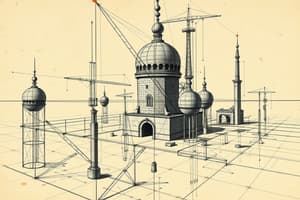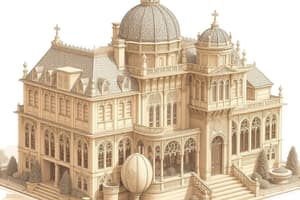Podcast
Questions and Answers
What is the first step in converting a 3D model to a 2D representation through orthographic projection?
What is the first step in converting a 3D model to a 2D representation through orthographic projection?
- Combine the multiple views into a single multiview drawing.
- Project all points along the axis to their respective planes, creating the first view.
- Repeat the projection process for additional views from other orientations.
- Align the 3D model with the chosen view by determining the appropriate angle between the viewing direction and the principal axes. (correct)
What is the purpose of creating multiple views in a multiview drawing?
What is the purpose of creating multiple views in a multiview drawing?
- To make the drawing more complex and difficult to interpret.
- To showcase the object from different angles without any additional benefit.
- To provide a more complete representation of the object. (correct)
- To create a more efficient drawing by combining several single-view drawings.
What is the main advantage of a multiview drawing over a single-view orthographic projection?
What is the main advantage of a multiview drawing over a single-view orthographic projection?
- Multiview drawings are more complex and detailed.
- Multiview drawings provide a more complete representation of the object. (correct)
- Multiview drawings require less effort to interpret.
- Multiview drawings are easier to create.
Which of the following is a common technique used in creating a multiview drawing?
Which of the following is a common technique used in creating a multiview drawing?
What is the main disadvantage of a multiview drawing compared to a single-view orthographic projection?
What is the main disadvantage of a multiview drawing compared to a single-view orthographic projection?
What is orthographic projection?
What is orthographic projection?
What is a key advantage of orthographic projection?
What is a key advantage of orthographic projection?
Which of the following is NOT a common application of orthographic projection?
Which of the following is NOT a common application of orthographic projection?
What is the primary disadvantage of orthographic projection?
What is the primary disadvantage of orthographic projection?
What is the first step in creating an orthographic drawing?
What is the first step in creating an orthographic drawing?
Flashcards are hidden until you start studying
Study Notes
Orthographic Projection
Orthographic projection is a method of representing three-dimensional objects using parallel lines and flat planes. It involves projecting each point of an object onto its corresponding plane. This process creates a two-dimensional representation of the three-dimensional object, which can be understood from various viewpoints. Orthographic projections are commonly used for technical drawings, architectural plans, engineering diagrams, and other applications where it is necessary to represent objects without perspective or foreshortening.
Advantages and Disadvantages
Orthographic projection has several advantages over other methods of representing three-dimensional objects. One key advantage is that orthographic projections provide clear, accurate representations of complex objects in a way that is easy to understand and interpret. They also allow for precise measurements and calculations, making them ideal for engineering and architectural applications. However, their primary disadvantage is that they do not convey depth perception or spatial relationships between different parts of the object.
Techniques
To create an orthographic drawing, one must first identify the orientation and position of the planes of projection relative to the object being drawn. Common techniques include placing the object at the origin, rotating the object about the x-, y-, or z-axis to align with the axis of interest, and then projecting each point on the object onto its corresponding plane using parallel lines.
Transformation into Orthographic Projection
The transformation from a 3D model to a 2D representation through orthographic projection involves several steps. First, the 3D model is viewed along a chosen axis by determining the appropriate angle between the viewing direction and the principal axes. Next, all points along this axis are projected to their respective planes, creating the first view. This process is repeated for additional views from other orientations, resulting in multiple views that together represent the object in its entirety. These views can be combined into a single drawing called a multiview drawing, which provides a more comprehensive representation of the object.
3D to 2D Conversion
The conversion of a 3D model to a 2D representation involves several steps. First, the 3D model is oriented to align with the chosen view by determining the appropriate angle between the viewing direction and the principal axes. Next, all points along this axis are projected to their respective planes, creating the first view. This process is repeated for additional views from other orientations, resulting in multiple views that together represent the object in its entirety. These views can be combined into a single drawing called a multiview drawing, which provides a more comprehensive representation of the object.
Multiview Drawings
Multiview drawings are the result of converting a 3D model into a 2D representation through orthographic projection. They consist of multiple views of the object from different orientations, which together provide a comprehensive representation of the object in its entirety. These views are often combined into a single drawing to create a more efficient and complete representation of the object.
Advantages and Disadvantages
Multiview drawings have several advantages over single view orthographic projections. They provide a more complete representation of the object, as they show the object from multiple angles. This can be particularly useful for complex objects, where understanding the object from a single view may be difficult. However, multiview drawings can be more complex to create and interpret than single view drawings.
Techniques
To create a multiview drawing, one must first determine the orientation and position of the planes of projection relative to the object being drawn. Common techniques include placing the object at the origin, rotating the object about the x-, y-, or z-axis to align with the axis of interest, and then projecting each point on the object onto its corresponding plane using parallel lines. This process is repeated for multiple views from different orientations, and the resulting views are then combined into a single drawing.
Studying That Suits You
Use AI to generate personalized quizzes and flashcards to suit your learning preferences.




